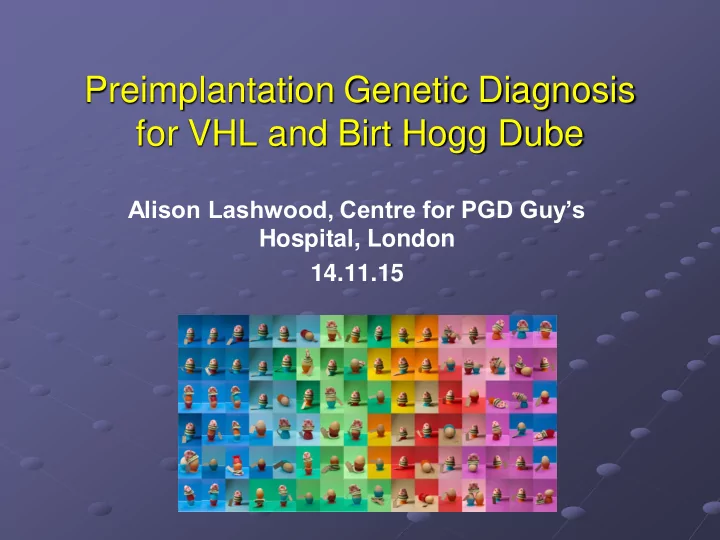

Preimplantation Genetic Diagnosis for VHL and Birt Hogg Dube Alison Lashwood, Centre for PGD Guy’s Hospital, London 14.11.15
The PGD team Specialists in Genetic Reproductive Counsellors & Medicine- Clinical Geneticists doctors & nurses Molecular scientists & Embryologist cytogeneticists s PGD Coordinator Paediatrician Researchers
Why PGD? Concern about having a child who inherits VHL/BHD Other options to prevent passing on the gene not acceptable or not first choice Other options include: Take a chance Test a pregnancy (prenatal diagnosis) Sperm or egg donation Adoption Have no children
UK law & licensing Human Fertilisation & Embryology Authority (HFEA) All centres must have a licence to offer PGD A licence is necessary for each new PGD condition VHL has an HFEA licence already
Cost & funding New NHS England funding policy. Up to 3 cycles Scotland, Wales & Northern Ireland have different policies To have funding agreed certain criteria must be met: No unaffected children of this union Female age is less than 40 yrs at start of treatment Non smokers Female body mass index (BMI) 19-29 HFEA licence If couple have to self fund it is around £ 12,000 per cycle
So how do we do it? PGD preparation timeline PGD genetics appointment HFEA licence application From 4-12 months Set up PGD laboratory test PGD fertility unit appointment Start of PGD cycle
PGD cycle Blastocyst biopsy with freezing Step 1 Step 2 Freeze all Making the embryos, Transfer of unaffected embryos while followed by biopsy frozen embryo testing completed. 12 weeks
PGD cycle to create embryos Ultrasound scan of Drugs used to stimulate the Fertilisation Egg collection egg production in with partner’s ovaries ovary sperm 3 weeks
Day 6 Day 5 hatching Growth of embryo Day 4 blastocyst Late Day 3 morula Early Day 3 16-cell stage Early Day 2 8-cell stage Late Day 1 4-cell stage Early Day 1 2-cell stage Fertilized egg (zygote)
Blastocyst Biopsy Blastocyst held in Trophectoderm cells Cells removed and position extrude through small sent for testing hole made in the outer coating of the embryo FREEZE ALL EMBRYOS
Embryo results to pregnancy test Test the biopsy Womb lining Embryo transfer Pregnancy test- from the embryos preparation Positive or negative 7-8 weeks
Then……….. If pregnant: If not pregnant: Follow up appointment Confirmation of PGD? Future options Antenatal care done - Use other frozen locally embryos Paediatric follow up; - New cycle - birth - Stop - 18 months
Does it work? (Sept 1997- Dec 2014) Cycles started 1741 Cycles to Embryo transfer 1255 (77%) Ongoing pregnancy rate: 31% per cycle started 43% per embryo transfer Probably higher because not all embryos have been transferred yet
Babies born (June 2015) Total babies born =626 464 singletons 147 twins (74 x 2) 15 triplets (5 x 3) 84 ongoing pregnancies
Success Limitations of Multiple rate PGD; what can we pregnancy risk test for? Things to think about Impact of Accuracy of travel & cost test with PGD Welfare of Health of the Emotional the child mother & rollercoaster pregnancy
So to finish….. PGD offers couples another option to have healthy children and success rates are improving. However it is important to discuss PGD alongside other options. Referral to specialist team needed by local genetics team It is complex and takes time so will not suit everyone.
Recommend
More recommend